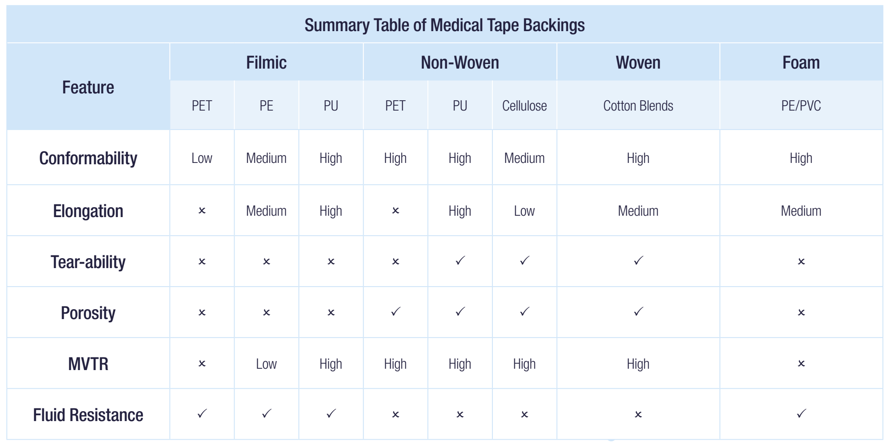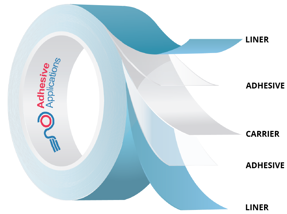Your Guide to Tape Carriers for Wearable Medical Devices

Wearable Medical Devices Are Booming
Wearable medical devices have become increasingly popular in recent years. We count on them to do everything from tracking our steps to dosing our insulin.
They're so popular that analysts expect the global market for medical wearables to reach almost $175 Billion by 2030. These devices can offer a convenient way to track our health in real-time, from fitness trackers to heart rate monitors, but for them to be effective, they need to stay in place and remain comfortable for the wearer.
That's where medical adhesive tapes and tape carrier selection come in.
|
This post will explore the importance of tape carrier selection regarding the medical-grade adhesive tapes used for wearable medical devices. Carrier selection refers to choosing the adhesive tape base material. The carrier is essential for the performance of wearable medical devices, and it helps the device stay in place and protects the wearer's skin from irritation. |
If you're ready to learn more about how tape carrier selection can impact your medical devices, let's go.
Medical Adhesive Tapes Explained
In our post about the new 3M Medical Tape 4576, we covered this topic, but returning to the basics is always good.
Medical-grade adhesive tapes are specialty tapes designed specifically for medical applications.
Medical tapes are often manufactured in special FDA-approved cleanroom facilities to minimize contamination and consist of medical-grade materials like silicone or polyurethane, which are non-irritating to the skin and can withstand prolonged exposure to sweat and moisture.
Medical-grade pressure-sensitive adhesive (PSA) tapes are essential to most wearable medical devices. These specially-engineered tapes need strong adhesion properties to keep them securely in place for long periods, all while maximizing wearer comfort.
And all of this can boil down to the adhesive tape carrier.
Adhesive Tape Carriers Explained
The tape carrier is the thin, flexible material onto which the adhesive is put. It aids in forming the material's structure, carries the adhesive, keeps the materials together, and protects the adhesive.
The carrier thickness can be critical when converting and die cutting the tape. For example, a thicker, firmer backing aids in the final product's form and stability.
Why Do Adhesive Tape Carriers Matter?
The tape carrier plays a vital role in determining the final performance attributes of a wearable medical device.
The carrier of a medical adhesive tape directly contributes to the look and feel of the final device and can impact how well it does in the field in several key ways:
- Moisture Vapor Transmission Rate (MVTR)
- Fluid barrier abilities
- Biocompatibility
- Tensile Strength
- Conformability
- Removability
- Thickness
If we look specifically at skin-friendliness or biocompatibility, we see that if the tape carrier is too rough, it can irritate or even damage the skin.
And if the carrier is too soft or the adhesive is not strong enough, it may not provide enough support for the medical device causing it to fall off the wearer early.
A 3M™ Summary of Medical Tape Backings
This table from the 3M™ whitepaper Selecting the Right Medical Adhesive Tape summarizes the key characteristics of different medical tape backings. It compares them based on several key attributes, including how well they conform to the skin, their strength, and their ability to allow air movement through them (breathability).

Understanding the key characteristics of different tape carriers allows medical device designers to choose a suitable tape for their specific application.
When selecting a carrier type for your medical tape, it's essential to consider the desired level of adhesion, conformability, strength, breathability, moisture resistance, the patient's specific needs, and the device's intended use.
Common Types of Medical Adhesive Tape Carriers Examined
The table above shows that the most common carrier types used in today's medical-grade adhesive tapes are film or filmic, non-woven, woven, and foam. Each tape carrier type has unique properties that can make it better suited for specific applications than others.
Filmic Tape Carriers
Film tapes typically consist of materials like polyurethane, polyethylene, or polyester. They can be coated with varying thicknesses of adhesive, making them a versatile option across a wide range of different end uses.
Film tape carriers are also relatively impervious to bacteria and viruses, making them a strong choice for medical devices designed to be worn for extended periods, as it helps reduce the risk of infection.
|
Known For |
Good For |
|
|
Non-woven Tape Carriers
Non-woven tape carriers are easily die-cut into various shapes and sizes, making them suitable for a wide range of wearable medical device applications. Non-woven carriers are made from materials like spun-laced polyester or elastic fabric.
Many lightweight non-woven rubber-based adhesive medical tapes, such as non-woven polyesters, feature lower adhesion levels, which offer greater flexibility and range of motion. This makes them ideal for use in devices that require movement or flexibility.
|
Known For |
Good For |
|
|
Woven Tape Carriers
Woven tape carriers are made of a woven fabric such as cotton, nylon, or polyester. They offer good strength and durability and can be coated with various types of medical-grade pressure-sensitive adhesives to meet specific application requirements.
Woven tape carriers are commonly used in wearable medical devices that require a strong and stable base.
|
Known For |
Good For |
|
|
Foam Tape Carriers
Foam carriers are constructed from soft, conformable foam materials and are known for their enhanced stability and comfort, especially in applications of sustained skin contact.
One of the main advantages of foam tape carriers is their ability to absorb and distribute pressure. This is particularly important in applications such as wound dressings and compression garments, where pressure needs to be distributed evenly to avoid injury to the skin.
|
Known For |
Good For |
|
|
Selection Factors for Medical Device Tape Carriers
The tape carrier you choose will depend on the specific needs and requirements of the wearable medical device. It is essential to carefully consider your options and select a carrier material that balances optimal device performance and the safety and comfort of the device wearer.
Carrier selection is critical in medical-grade adhesive tapes used for wearable medical devices. The right carrier can help ensure the device is comfortable, secure, and non-irritating to the skin.
What Have We Learned?
- Experts predict the global market for wearable medical devices will reach $175 Billion by 2030.
- Medical adhesive tapes ensure medical devices remain in place without irritating the wearer's skin.
- The adhesive tape carrier - the base material to which the adhesive is applied - must be strong, durable, gentle, and non-irritating to the skin.
- Common medical tape carriers are film, non-woven, woven, and foam.
- Different tape carriers mean you have options:
- Conformability, tensile strength, biocompatibility, MVTR, fluid barrier, removability
- Medical tape carrier selection is critical to the success of your wearable medical devices
JBC Technologies & Medical Tape Selection for Wearable Devices
You've chosen JBC Technologies because you know it's important to partner with a material converter and die cutting partner familiar with the ins and outs of medical tape selection and application.
When developing or manufacturing a wearable medical device, it's critical to carefully consider the carrier type and pressure-sensitive adhesive combination to ensure that you get the best possible results from the final device construction.
The carrier material should be chosen based on end-product requirements such as breathability, conformability, strength, skin compatibility, and other factors.
To learn more about selecting the right medical adhesive tape for your wearable devices and to schedule a consultation to discuss your custom medical die-cutting project, contact us today.
